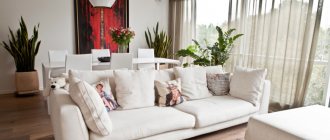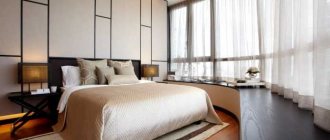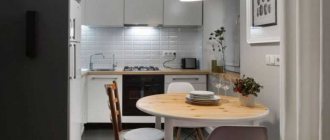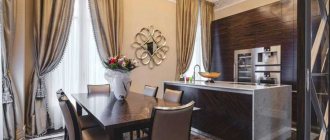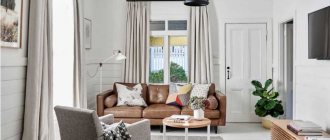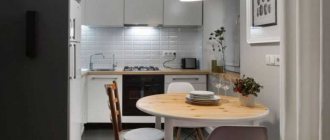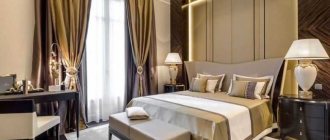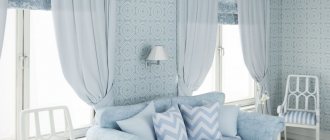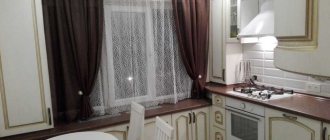Every year at the interior fair held in Milan, leading designers present new items that correspond to the current fashion. A modern interior should be stylish, so every interior design specialist tries to present the best work, using new fabrics and accessories, as well as developing an interesting design.
Tulle plays an important role in the interior, so it does not lose popularity and relevance. Textiles add coziness to the room, so plastic blinds and Roman blinds made of synthetic materials, despite their practicality, give way to light and airy tulles.
Curtains in a modern interior
How to choose the right tulle for the hall, what to look for and how to combine it with curtains and curtains? These are the questions that concern everyone who independently designs rooms.
Basic criteria for choosing tulle for the hall
Before you start choosing curtains for the main room of your house or apartment, you should familiarize yourself with the recommendations of interior designers. They advise taking into account important points.
Lighting and windows
This is the main thing that requires attention. The living room should have enough light, so it is better to give preference to light, pastel shades, including white. Bright curtains are suitable only for rooms with northern and western orientation, as well as for children's rooms. In a teenage boy's room, curtains in cold colors - all shades of blue and gray - would look appropriate.
The shape of the windows, their height and number dictate their own rules when selecting curtains. For example, if the opening is large, then tulle with a pronounced vertical pattern is suitable. It will balance the space and visually raise the ceiling. If the windows are located too low and there is a large distance above them to the ceiling, it makes sense to install a molding or wall-mounted cornice.
In typical apartment building projects, the living room often has access to a balcony. Therefore, it is important to properly decorate the living room with balcony windows and doors. It is appropriate to hang curtains and tulle curtains made from separate pieces of fabric here.
You might be interested in what satin is: description of fabric for curtains
Decorating the exit to the balcony
By functionality
You should choose tulle for the hall, taking into account natural light. If the windows face the east and south, then it is better to give preference to dense natural fabrics in light shades. They block bright sunlight, protecting furniture and other interior items from fading. Modern linen tulle can be used as a material. Tulle in the interior of rooms into which little light enters is best used from light transparent fabrics and meshes.
If curtains serve a decorative function, then it is important to choose the right color. It can be combined with the main accent of the interior, for example, the largest piece of furniture. Or, on the contrary, serve as a background. In this case, you should choose neutral shades - beige, milky, olive.
Sheer tulle in contrasting color
By interior style
The main room should be harmonious, so special attention should be paid to style. For classic and baroque interiors, tulle is suitable, design options for which allow the use of lambrequins, tiebacks, tassels, as well as gold threads and embroidery.
For minimalism and hi-tech, a curtain can become the main element of decor, so bright plain fabrics and textured materials of coarse weaving are allowed.
Provence, chalet, shabby chic require the selection of tulles with floral patterns and lace fabrics. Typically, patterned tulle in the interior duplicates other textile elements, for example, chair covers or sofa upholstery. The design of curtains for these styles allows the use of frills, draperies, and lace inserts
Lace
For ethnic style interiors, fabrics with a pronounced texture and large patterns are suitable. Tulle can be decorated with gold and rhinestones if the interior is designed in an Oriental style. For African ones, motifs with animals, bright and rich colors are suitable.
The Scandinavian style will be supported by tulle curtains in cool tones. Alternating transparent and matte stripes is appropriate here.
Important! When choosing tulle for rooms, pay attention to the combination of texture and color of curtains.
How to choose tulle for the hall
allow you to visually increase the height of the ceiling and give harmony to the interior. If they are chosen correctly, the atmosphere of the room becomes more comfortable. The practicality of tulle is to protect the room from sunlight and from the gaze of passers-by.
The correct choice of curtains provides not only an aesthetic, but also a practical purpose for decorating a room. It consists in protecting it from the sun or visually expanding the space. Ready-made curtains for the hall have their own advantages. When tailoring individually, you can choose tulle of different colors, styles and sizes.
To choose the right tulle, you will need to decide in advance where the curtains will be located. Since curtains play different roles in the interior, they can represent an interesting accent or background for exclusive items in the room.
You can choose suitable tulle based on the following rules:
- classic style involves choosing curtains made in soothing colors;
- you can combine contrasting colors depending on the size of the room;
- saturated shades are not suitable for small spaces.
The selected tulle color should be psychologically favorable. For example, black color can have a suppressive effect on the human nervous system. This color should not be allowed to overshadow the others, so it is best to use it only for contrast. If you focus your attention on bright orange curtains, they will irritate even choleric people.
The selected tulle can be hung on curtains with eyelets, which have a number of advantages:
- reliable fastening of curtains to the cornice;
- a spectacular view due to the beautiful waves with which the tulle falls;
- ease of use, as they are easily pulled.
You may also be interested in: Wool blankets are the key to good health
When choosing, you should choose the most suitable option that will complete the interior, since tulle can transform a room.
Select tulle by color and material
Modern tulles are very diverse. This makes it possible to choose both luxurious curtains for a rich Baroque, Rococo and Art Nouveau interior, as well as inexpensive options for rooms decorated in the style of minimalism, hi-tech, and loft.
You may be interested in everything about furniture chenille: the properties of such fabric
New technologies make it possible to create practical fabrics that are easy to care for.
The market offers materials such as:
- silk;
- organza;
- viscose;
- muslin;
- tulle;
- veil;
- nylon
However, today there is a tendency to prefer natural materials. Modern tulles made of linen and cotton fibers are suitable for eco-style interiors.
Pay attention to the weaving of the threads - fashionable tulle has a simple square weave like burlap with seals and knots.
Linen
What fabric is best to choose for the living room?
You can radically change the overall look of your living room with the help of the right fabric. After all, this is the final element of the interior.
Organza
Strong, translucent fabric. Made from silk, viscose and polyester. Thanks to the wide range and color variety, organza combines perfectly with other fabrics and is an ideal option for decorating a window opening. It transmits light perfectly and creates coziness in the room.
Veil
It has the ability to diffuse natural light, making it especially suitable for darkened rooms.
See more photos of voile curtains in the interior.
Kiseya
It is used in the hall not only to decorate windows, but also to separate zones. It features high-quality room ventilation.
The photo shows a living room in the interior of which, weightless muslin successfully divides the space.
Chiffon
This fabric has different density characteristics. All types of this material create spectacular folds and drape well. Suitable for the living room when decorated in a minimalist style.
Rules for choosing tulle for the living room
Beautiful tulle for the hall is an important element that requires maximum attention when decorating the interior.
Simple rules will help you make the right choice:
- Maintain style by choosing tulle designs.
- Take into account the lighting of the room, orientation to the cardinal directions.
- Choose a color in accordance with the shade of walls, furniture and other decorative elements.
- Take into account the size of the window, the presence of a door, the height of the ceiling, and the area of the room.
Additional Information! Vertical stripes visually lift the ceiling, horizontal stripes expand the space.
Light colors add light, dark colors add intimacy.
How to choose tulle for a Japanese-style living room
Japanese curtains are a screen where the fabric is attached from the bottom and top to two guides. There can be many such screens, from two to eight canvases stretched over slats. The style requires the use of natural materials, so the choice should be made of linen, cotton, and bamboo fabric. Japanese style does not exclude the use of patterned curtains.
Japanese style living room curtains
How to choose the right tulle for the living room
Read about: organza: fabric for a festive mood.
The choice of tulle for the living room depends on many characteristics, how to choose curtains and tulle for the living room
so that they look harmonious. Selecting the right combination, taking into account the color scheme of the room, its size and style, will completely transform it.
Color
Color depends on the following factors:
- Room size;
- Season;
- Main purpose;
- Will be an accent or complementary element.
If you choose the right color, even a small room will become visually large and bright. Light transparent material in light shades is suitable for the living room if the windows are directed to the north or east. If the room is large and well-lit, then there will be more choice. For example, you can pay attention to curtains with large patterns or options in rich colors.
Designers advise changing curtains depending on the time of year. The weather outside the window affects a person’s condition, while the interior environment of the house can compensate for the excess or lack of light. If the room is not on the sunny side, then in summer it is recommended to use light tulle. It will help the air circulate freely. You can choose cool shades, this will add freshness. In winter, experts advise decorating the room with thick fabrics in warm colors.
Tulle can be used both independently and as an addition to the overall picture. In the first case, it is allowed to use both active (bright colors, patterns, complex textures) and plain models. If several colors are used in the design, they must match in shade (either warm or cold).
Tulle for the living room (see photo) is best combined with curtains. This option will look more expensive and more appropriate. A pattern would be useful for this room. These can be all kinds of curls and herbal designs, flowers and geometric shapes are also appropriate.
The shade is selected depending on:
- General color scheme;
- Furniture colors;
- Wallpaper colors;
- Textile colors.
If the living room is decorated in light colors, then this gives room for imagination. You can choose a “rainbow” option, warm shades or rich dark shades (burgundy, chocolate, emerald). The dark shades of the room are “active”. In this case, the tulle shade should be much lighter than the wallpaper or furniture.
The walls in the living room may have a small characteristic pattern. In this case, when choosing tulle, it is necessary to adhere to a similar texture or choose a smooth, monochromatic option. The presence of an active picture in this case is unacceptable.
Style
If you want to adhere to a certain style to create the “atmosphere” of the room, then great attention must be paid to the details.
Provence
This style implies lightness. Usually light shades are used (blue, wheat, white, lavender) or a pattern with a small flower or stripe. In this case, the tulle should be as airy and transparent as possible, so as not to disturb the feeling of “freedom”. A great combination would be with decorative pillows in this style.
Classical
A living room in this style should be functional and aesthetic. A sense of “solemnity” would be appropriate here. Classic style curtains are distinguished by their multi-layered nature. Tulle can be of several matching colors, and complex lambrequins can also be present. You can use a light base in combination with complex details, and vice versa. White, brown, and cherry colors are usually used.
Minimalism
If you decide to choose a minimalist style, this means that you do not like clutter and unnecessary details. This style contains only the essentials. All items are functional rather than decorative. Curtains in this case should be as simple as possible. They blend into the background rather than being an accent.
Eco
This style involves decoration with “natural” materials. These include cotton and linen. Shades used: sand, “dusty” green, muted white or yellow.
Baroque
Synonyms for this style are “pomp,” “luxury,” and “pomp.” The curtains in this case are the most elaborate, rich and complex. They are replete with many additional details. Tulle will usually have an interesting intricate pattern. It can be an ornament, waves or a pattern. In this style you will not find a uniform, simple base. Every detail “screams” about its significance and originality. You can find gold inserts, stripes or drapery. This style is sometimes compared to the classic one, however, it is impossible to confuse them. In the Baroque style there are no main or additional details. All its parts are accents.
Tulle and curtains - how to combine correctly: options for a room without curtains
Classic window design involves the use of a combination of tulle and curtains made of thick fabric. The emphasis is on one of the elements - either a curtain or thin transparent tulle.
However, modern interior design allows you to abandon curtains. This option is welcome for living rooms with large panoramic windows.
Tulle in rooms without curtains carries the main decorative load, so the color and texture should be selected taking into account the style of the interior. Classic, Baroque and Art Nouveau suggest rich fabrics made from natural silk. They can be decorated with embroidery, lurex, tassels and tiebacks.
For avant-garde styles, smooth translucent curtains made of mesh and simple weave fabrics falling in uniform soft folds are suitable.
You might be interested in what fabrics are used for car seat covers
Transparent curtain for panoramic glazing
Important! Tulle without curtains in the interior is not suitable for the first floors and when buildings are close together.
To protect yourself from prying eyes, you need to curtain your windows with thick fabrics.
Materials for making tulle
When choosing a material, you should take into account the seasonality of its use. An important criterion for choosing tulle for a room without curtains is the completeness of the appearance of the entire structure. The material can be combined from dense and transparent fabric, which is plain or decorated. Grommet curtains are a common option for this design.
You may also be interested in: Color combination in the interior
If you choose curtains made of fabric with a complex texture, they can be successfully combined with tulle curtains. Making a product yourself is quite difficult, since the type of fabric is always taken into account during the cutting and sewing process. Improper sewing will lead to the material being overstretched, wrinkles forming on it, as well as a number of unaesthetic waves.
If you combine synthetic tulle material with artificial curtains, then these 2 interior elements may not look the way the owner of the room would like. Artificial and natural light will distort the shades of the curtains. This factor is important to consider when choosing material for them.
The use of complex decorative elements in the interior requires a choice. These models can consist of several layers, including additional elements. Tulle looks beautiful with a lambrequin and artificial inserts. It emphasizes the originality of the luxurious room, where elegant pieces of furniture are located.
The opening should be decorated very responsibly, since it represents the basis of the interior. A wide variety of fasteners, materials, and accessories allows you to create even quite complex images. If you don’t want to show your creative imagination, then it’s enough to opt for a suitable ready-made kit.
Choosing tulle for the hall: trends and new items
Designers believe that in the near future fashion will dictate the rules of minimalism in everything. Therefore, curtains should be of restrained tones, without pompous lambrequins, elaborate decorations, or multi-level draperies.
With the advent of photo printing technology, it became possible to apply a wide variety of designs to thin translucent fabrics. Today, this solution for window decoration is very popular. A real gift could be designer hand-painted silk curtains.
Phototulle
Which cornice do you prefer?
An important element of window design is the type of curtain fastening. However, the choice of cornice depends on the style of the interior.
- For the classics, baguettes and round rods are suitable, on which the curtains are strung using eyelets.
- For avant-garde interiors, it is better to choose thin strings or a flexible aluminum profile.
- Multi-row Japanese curtains require the use of rail or rail curtain rods.
The curtains can be mounted on the ceiling or on the wall. The choice depends on the height of the ceiling.
Forged cornices
Important! The weight of the curtains must be taken into account. If tulle is combined with heavy velvet hailstones, then it is better to choose durable metal or wooden rod curtain rods.
Tulle, brief description, varieties, ideas for the hall
Tulle is a transparent, translucent fabric similar to a mesh. It is made using special curtain machines and painted in almost any color. You can select a product to match almost any existing interior, if it has at least some curtains.
You can radically change the overall look of your living room with the help of the right fabric.
Modern types of tulle in appearance are:
- transparent;
- matte;
- thread-like;
- in the net;
- with lace;
- decorated with embroidery.
An original way to decorate a small space.
Fabrics used:
- muslin;
- veil;
- muslin;
- net;
- batiste;
- tulle;
- jacquard;
- chiffon;
- organza.
They filter light especially beautifully and do not overload the space in the hall.
The photo also shows different ways of attaching tulle to the hall:
- on hinges;
- on eyelets;
- using braid.
Can be combined with any interior design.
Transparent curtains vary in length and location. In the spacious combined spaces of kitchens-living rooms, bedrooms-halls, studio apartments, the finest drapery, suspended on a cornice hidden in the stretch ceiling, can become an original zoning element that plays a purely symbolic role. You can hang such textiles both on windows, combining them with each other, and on a wooden, plastic, metal door, or arched opening. In the latter case, a “scattering” thread product is optimal.
Such curtains in the hall look much more interesting and original than ordinary ones.
- Modern tulle in the interior: photos, types, colors, combination with other curtains
Advice. The use of tulle curtains of one type or another, color, depends on the size of the space being designed and its stylistic design.
How to properly care for tulle
Tulle is a thin and delicate fabric that requires careful handling. Washing should be done in a gentle mode at a temperature not exceeding 40 degrees.
It is necessary to rinse the fabric thoroughly so that the remaining powder, when exposed to sunlight, does not cause the formation of yellow spots. Chlorine-based bleaches can only be used on natural materials. Adding table salt to the washing water will help to achieve ideal cleanliness of synthetic tulle.
It is better not to iron tulle curtains. To get rid of creases, it is better not to wring out the tulle, but to let most of the water drain and hang it wet on the curtain rod.
This approach will keep the delicate fabric in good condition for a long time.
